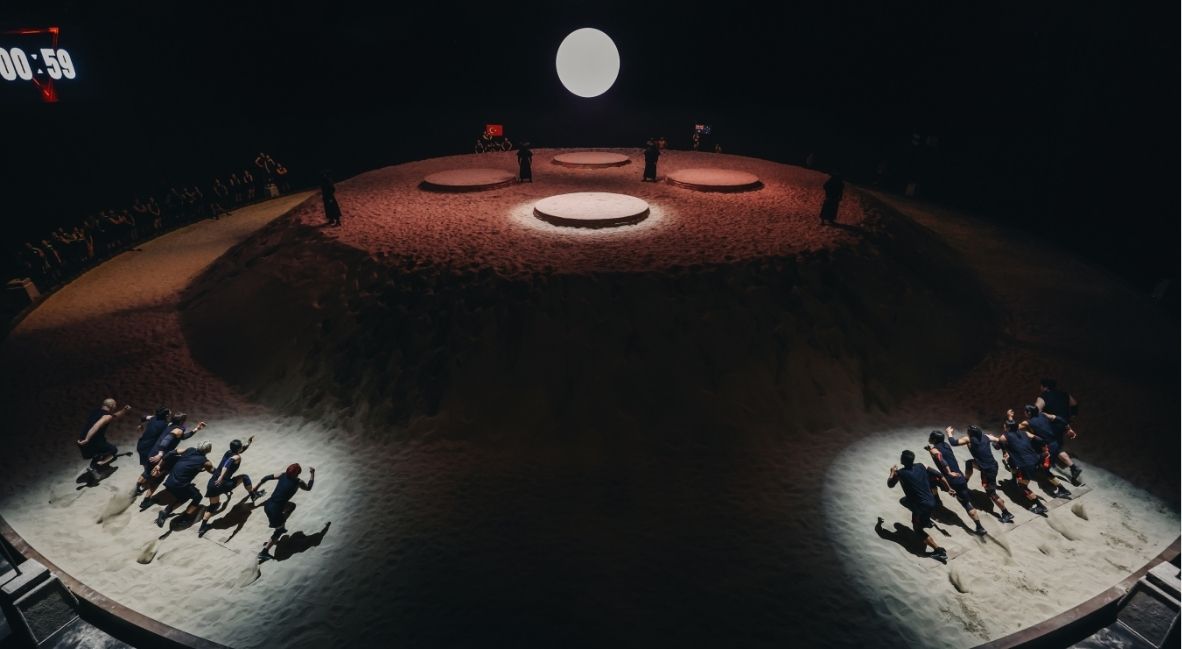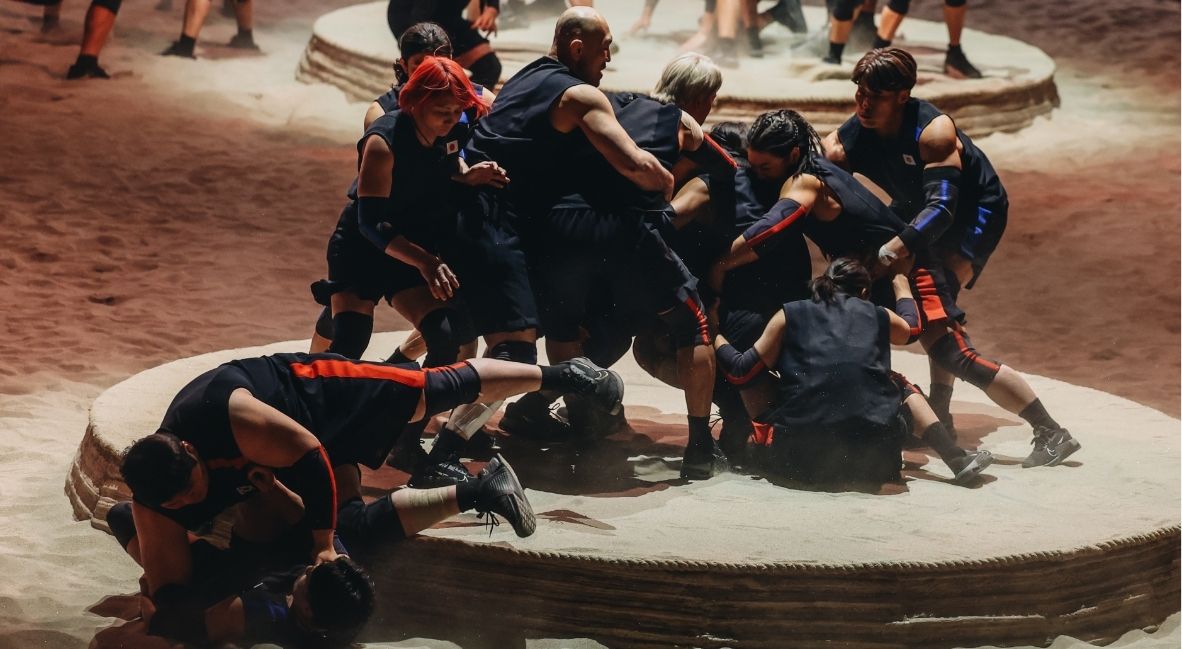This article features spoilers for Physical Asia Episode 1 through Episode 4.
Physical 100 redefined competition series for Netflix, and beyond. Without a focus on gender or beauty, the series reframed the hunt for the best physique as finding the strongest competitor among 100 in South Korea. Since its release in 2023, the series has expanded with a Season 2, inspired an Italian spin-off, and now has entered the world international competition with Physical Asia.
With competitors from across Asia, Physical Asia brings together 48 contestants from different backgrounds, all competing to bring home the title of the strongest to their home countries. The series has representatives from South Korea, Japan, Mongolia, Indonesia, the Philippines, Thailand, Turkiye, and Australia.
Yes, Australia often competes in Asian competitions, and Turkiye is a part of Central Asia. And that is the first reason why we love watching international sports, learning more about the countries we’re watching.
Now, Physical Asia isn’t a geography lesson, but it does show audiences the diversity of sports, professions, celebrities, and people who participate in what constitutes Asian games. Part of what comes with learning more about the world is learning its history. Posting is at its best when you’re reading accounts posting on social media while supporting their teams in the FIFA World Cup, or even the Euros, Gold Cup, or any other international football tournament.
Why? History.
The rivalries in international sport aren’t just about proximity or win-loss records. They’re deeply ingrained in international pride. The Irish football fans chanting “Lizzy’s in a box” wasn’t about the exact moment on the pitch, but about the historical hatred for an occupying ruler. That’s a football chant. That kind of competition and animosity that encourages the refusal to give in is alive and well, and Physical Asia leans all the way into it.
Physical Asia leans on history the same way that international sports fans do.

In the opening episode, the teams compete in a test called “Territory Conquest.” With a red sun rising behind a sand mound with four platforms, it’s clear what this test is meant to represent. The producers and set builders on Physical Asia don’t know what subject is, and that’s out loud and clear.
But while those histories are involved on the outside, the cordiality of the opponents isn’t affected. They greet each other, size each other up, and meet with respect. But when the first challenge winds up with Korea and Japan going to 6 overtime matches after both refuse to give, and only ends with a rule adjustment, the tension is there.
With the Japanese captain noting that the challenge seems inspired by Japan’s national sport, Sumo, the team’s sense of urgency to win feels heavier at the beginning. But as Team South Korea found themselves constantly in overtime first against Turkiye and then Japan, the grit comes out.
And time and time again, the interview packages that the series splices throughout the challenges show the Korean team explaining how they can’t lose to Japan. While nothing is explicitly said, if you’ve spent any time watching international sport, well, you know what’s happening. The drama of national pride deepens when it clashes with historical factors and stereotypes associated with different countries or sports.
The Physical Asia cast is locked in on the competition, and it’s a matter of national pride.

We watch international sport for intensity, something more than just playing for a club or team, but for a pride larger than that riding on the win. International sporting competitions are about more than just winning, and there is nothing like it. It’s where people tap into their patriotism and wear it proudly.
To begin Physical Asia, each team captain is asked to say something. Where some of the captains chose generic messages about power (Turkiye, Australia, and Indonesia), others demonstrated their culture in their introductions.
For South Korea, Captain Kim Dong-hyun spoke about the importance of strength from within, ending with “the resolve of our people is the strongest in the world.” After him, the Japanese captain, Yushin Okami, spoke about Japan’s recognition as a nation of warriors. Keeping with the theme, Suppachai “Superbon” Muensang, Thailand’s captain, said that the “fighting spirit” of Muay Thai comes from “the heart of Thailand and the hearts of the Thai people.”
For the Mongolian team, their captain, Orkhonbayar Bayarsaikhan, began by saying, “We are Mongolians, descendants of Genghis Khan.” As they start every match, the team raises their arms to the sky like pulling a bow and arrow and shout, “mount up.” As for Manny Pacquiao’s moment, the boxing legend said that Filipinos have “champion blood,” and that’s why they will win.
History and culture expand beyond just war. When you step back and look at the different backgrounds of each competitor, you see national pride on display in the sport they are representing. While many of the competitors are mixed martial arts fighters—Dong-hyun “Stun Gun” Kim and Yushin Okami even have a friendly rivalry over holding the Asian record for wins in the UFC—it’s the folk sports on display that teach the others in the room and the audience about different national folk sports.
Physical Asia Episode 1-4 gives audiences and other contestants the chance to learn more about each other’s countries.

Almost every team has an athlete for a sport that originated or is considered the national sport of their country. While many of the casting info or reviews call each of these men westlers, their sports themselves deserve much more attention, given how proudly they each explain the sport to the audience in Physical Asia Episodes 1 – 4.
Each of those athletes showed up in traditional dress, as they would for a match in their respective sports. For South Korea, their largest competitor, Kim Min-jae, is the top ssireum fighter in his weight class. A form of wrestling in Korea, the sport is done in sand with each competitor wearing a saba, a belt that wraps around their waist. To win, opponents must get any part above the knee of their opponent to the ground while holding onto the belt.
Turkiye’s largest competitor and team captain, Recep Kara, is also a professional wrestler in his nation’s style: oil wrestling. With a history that goes all the way back to Babylonia, it is just as it sounds. In traditional pants, two competitors wrestle each other while oiled, making controlling the other wrestler more difficult. And yes, he shows up to the introductions oiled up.

Keeping the theme alive, the Mongolian captain, Orkhonbayar Bayarsaikhan, is a Bökh wrestler. A traditional form of wrestling in Mongolia, his combat sport dates back to the time of Genghis Khan. While it’s a sport, wrestling is the most important of the “three manly skills” that have defined Mongolian culture, along with horsemanship and archery, all of which go back to the time of Genghis Khan.
Outside of the wrestlers, martial artists and other national combat sports are also represented. While much of the mixed martial arts world uses Judo, it originated in Japan, making judoka Soichi Hashimoto’s pride in his sport even larger. It’s even a topic of one of his interview sports when he effectively pins Korea’s Kim Min-jae, who is nearly three times his size, in one of the “Territory Conquest” bouts.
The last of the traditional sports is kickboxing, and Thailand’s team captain, Superbon. A world champion Muay Thai fighter, Muay Thai is Thailand’s national sport and has become the foundation for many of the modern mixed martial arts styles that you see in UFC.

The pride you see as each contestant takes on the others in the very first physical challenge, which relied heavily on brute strength with some focus on strategy, is on full display. This is especially true for the folk wrestlers on each team.
Outside of that, Physical Asia Episode 4 ends with Superbon and Pacquiao entering the elimination challenge in a 2v2 fight for control of a medicine ball in the center (an oldie but goodie for the Physical franchise)—a Muay Thai fighter—the kickboxer—against one of boxing’s most decorated fighters. While the screen cuts to black and we have to wait for the next episode, the excitement on Superbon’s face says it all.
At a certain level, Physical Asia is just adding a spin to their already winning formula. I’m sure that if everyone were competing individually, I would still have tuned in with excitement. But with everyone competing on teams, the gravitas of match-ups is felt more with every team needing to work as one unit, defending its weakest members and not relying on its strongest.
Physical Asia Episode 1-4 opens up the series with all the reasons we love international events.

But outside of the pride that comes from playing for a national team, there are also the jokes, and at just four episodes in, we’ve already gotten a great one when Thailand went up against South Korea in the second challenge, “Shipwreck.”
In his interview, national volleyball player James Rusameekae went on some of the best comparison jokes I’ve seen in a while. But the kicker was when he said, “Look, I’m not afraid of anything. Korea might have kimchi, but Thailand’s got som tam. Korea might have Korean Air, but we’ve got Thai Airways. And sure, you gave us BLACKPINK’s Jisoo, but we gave you BLACKPINK’s Lisa. We’re practically equals!”
We watch international sport because it gives us the grit and determination you just don’t find elsewhere. But that goes beyond just the physicality of it all; it also goes to the jokes that come from it. The ones that have more to do with history and cultural touchstones than anything else in the match.
While all eyes will be on James —thanks to how effortlessly funny and incredibly powerful he is —for more jokes, I can’t wait to see more of each team’s personalities on display as the episodes keep coming. Add in national pride, very pointed challenges, and more, and Physical Asia understands exactly why we tune in not just to competition but to international sport.
Physical Asia Episodes 1-4 are streaming now on Netflix with new episode batches dropping every Wednesday through November 2025.








